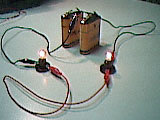


|
Serial circuit
Science at Home |
||
|
Materials
|
|
Videos: download.avi (344 KB)
Pictures: 
|
|
Procedure
1. Link the positive (+) and negative (-) poles of the two batteries. 2. Link the string (1) crocodile to pole (+). 3. Link the other string (1) crocodile or tip to one of the support (1) connections. 4. Link the remaining support (1) connection to one of the support (2) connections. 5. Link the remaining support (2) connection to batteries pole (-) with string (3). 6. Put one of the lamps in support (1). What happens? 7. Put the other lamp in support (2). The lamps start to shine? 8. Remove the lamp of support (1). What do you verify? |
||
|
Why?
With this experiment you can verify that removing one of the lamps of the circuit, the other lamp fades instantly. This happens because the lamps in the circuit are disposed in serie. In an electric circuit, the electrons move from the positive pole (+) to the negative pole (-). When removing one of the lamps out of the support, the electrons flow in the string is stopped. That can be compared to traffic in a freeway. Imagine that a certain freeway, that connects city A and B, is closed and that this connection road is the only one available. It would cause no possible connection between the two cities because the cars were not allowed to circulate. The same way, in the present experiment, the electrons in the serie circuit only have a way to flow. If it is closed, the electric current becomes zero. In other words, the lamps fade because there are no electrons flowing in the circuit.
|
||
 |
No part of this website can be reproduced without previous authorization. Please inform me if there is any problem with the website. |